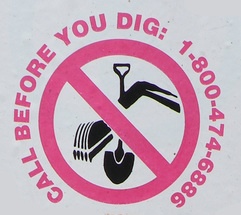Before digging into the ground, it is critical for drilling crews to know what hazards may lie down below. Calling in Line Locates is the law in all states. When crews start drilling without that knowledge, they could hit a water main, a gas line or an underground storage tank. This can be hazardous to the crew and damaging to the drilling equipment.
Line locates and ground penetrating radar (GPR) are two of the more common methods of figuring out what is below a work site.
What Are Line Locates And Ground Penetrating Radar?
If you have ever needed to do any digging, you may have called your local utility company about marking any underground utility lines. That is a line locate service. The service person uses a detector and utility maps to figure out where the lines are. Then, he uses spray paint to mark the approximate location of the lines. That tells the crew doing the digging where to use caution when digging.
Ground penetrating radar uses electromagnetic microwave pulses to locate things within the ground. When the pulse hits a gas line, water main or underground storage tank, or an underground anomaly, it reflects back to the radar's receiver. This gives a snapshot of what lies down below. By passing the radar across the ground several times, a full picture of what is below develops.
Which Method Is The Best One To Use For Drilling Projects?
For many years, line locates have been the norm on many drilling and digging projects. It is a free service, in most cases. The utility company handles scheduling the line location person to come out and do the job. That means the contractor does not need to bring out any special equipment to the site. This makes it easy and convenient for the project crew.
However, line locates are not the best option on many drilling projects. Many sites are on land that has had people living, working or building on for decades. Storage tanks, clay pipes and other man-made structures could be underground and no one may know. The line locate service would not know to mark those spots.
A GPR can give the drilling crews a complete profile of what is down below. This avoids problems with drilling into an underground storage tank or hitting an unknown gas line. While the contractor needs to hire a crew to perform the scan, it is time and money well spent to avoid a hazardous situation.
Environmental drilling often involves areas where underground utilities and storage tanks are close. Ground penetrating radar allows drilling crews to pinpoint sites that avoid tanks and utilities completely. If you have environmental drilling needs, give Talon/LPE Drilling Services a call.

